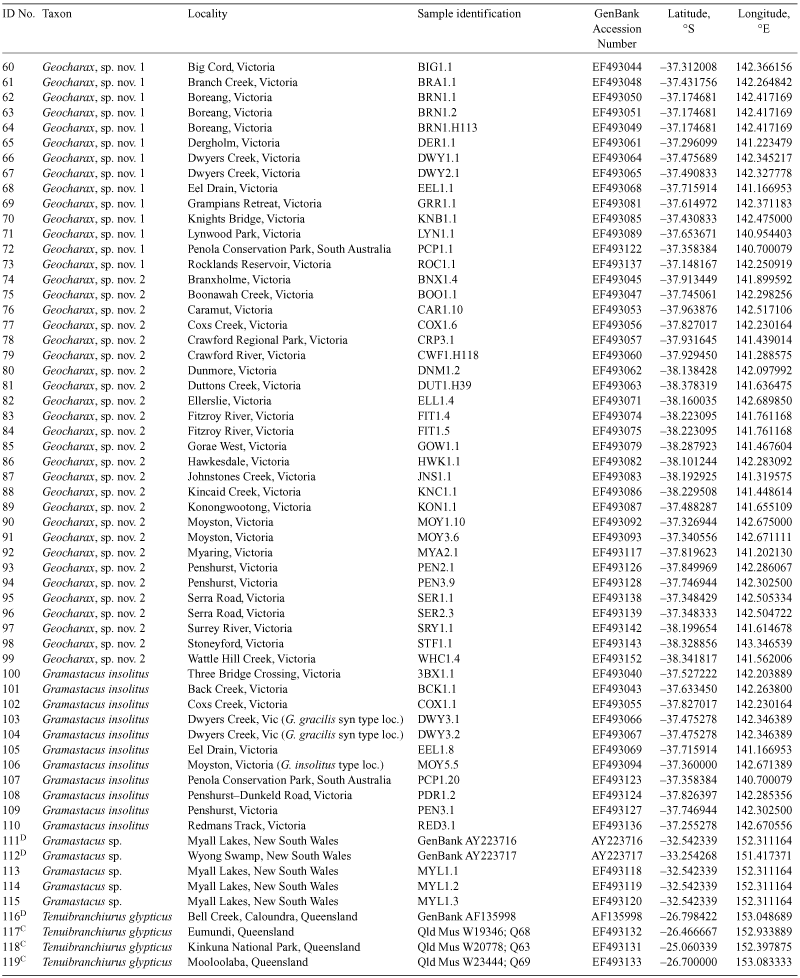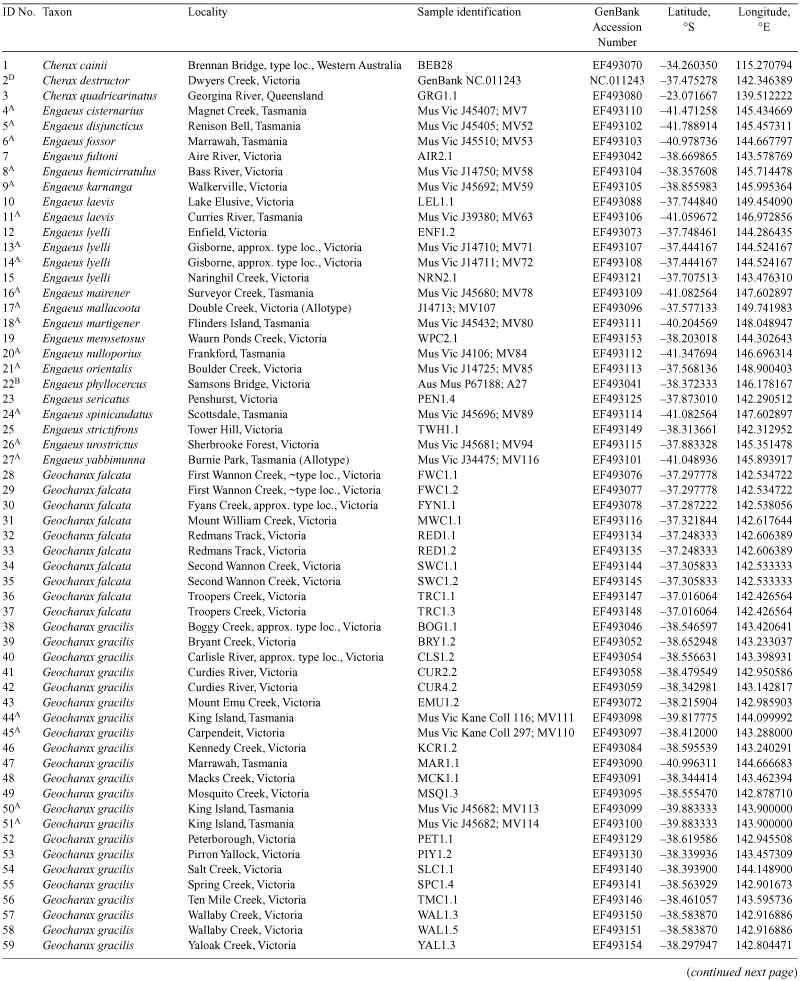Cryptic diversity in Engaeus Erichson, Geocharax Clark and Gramastacus Riek (Decapoda : Parastacidae) revealed by mitochondrial 16S rDNA sequences
Mark B. Schultz A , Sarah A. Smith A , Alastair M. M. Richardson B , Pierre Horwitz C , Keith A. Crandall D and Christopher M. Austin E FA Arafura Timor Research Facility, School of Science and Primary Industries, Charles Darwin University, PO Box 41775, Casuarina, Northern Territory 0811, Australia.
B School of Zoology, University of Tasmania, Private Bag 5, Hobart, Tasmania 7001, Australia.
C School of Natural Sciences, Edith Cowan University, 100 Joondalup Drive, Joondalup, Perth, Western Australia 6027, Australia.
D Department of Integrative Biology, 675 Widstoe Building, Brigham Young University, Provo, UT 84602-5255, USA.
E School of Science and Primary Industries, Charles Darwin University, Darwin, Northern Territory 0909, Australia.
F Corresponding author. Email: chris.austin@cdu.edu.au
Invertebrate Systematics 21(6) 569-587 https://doi.org/10.1071/IS07019
Submitted: 12 May 2007 Accepted: 23 October 2007 Published: 18 December 2007
Abstract
Nucleotide sequence data from the mitochondrial 16S rDNA region were utilised to investigate phylogenetic relationships and species boundaries among Australian freshwater crayfish belonging to the genera Engaeus Erichson, 1846, Geocharax Clark, 1936 and Gramastacus Riek, 1972. Geocharax and Gramastacus were found to be monophyletic genera but one species currently assigned to Engaeus may belong to another genus. Relationships between the three existing genera were not resolved. Analysis of species boundaries within Geocharax suggests that there are an additional two species in this genus, and our analysis of Gramastacus indicates that undescribed populations from central New South Wales may comprise a second species. The data provide at least one instance of a taxon crossing the Great Dividing Range and provide confirmation of previously proposed hypotheses seeking to explain trans-Bass Strait distributions of species.
Additional keywords: molecular taxonomy, parastacid, phylogenetics, South Australia, south-eastern Australia, Tasmania, Tenuibranchiurus, Victoria.
Acknowledgements
This work was supported by ARC Discovery grant number DP0557840 to A.M.M.R., C.M.A., P.H. and K.A.C. For their help on various aspects of molecular and statistical genetics, we thank Dr Binh Thanh Thai, Dr Christopher P. Burridge, Dr Dianne Rowe, Dr Nicholas P. Murphy, Dr Adam D. Miller, Claire F. McClusky, Sally-Anne Williamson and Dr Todd Castoe. For their generation of some sequence data, we thank Dr Adam D. Miller, Assoc. Prof. Marina Paolucci and Dr Hemali Munasinghe. For access to museum specimens, we thank Dr Gary Poore and Dr Joanne Taylor (Museum Victoria), Dr Peter Davie (Queensland Museum), Dr George Wilson, Dr Stephen Keable and Dr Shane Ahyong (Australian Museum). For provision of samples, we thank Céleste Jacq, Claire McClusky, Dr Lachlan Farrington, Steve Wickson, Dr Belinda Robson, Kerrylyn Johnston, Simon McBeth, Dr Binh Thanh Thai, Tan Thi Nguyen, Hung Quang Le, Robert McCormack, Dr Adam Pope, Jarred Obst and David Nichol (GHCMA), Darren Welsh, George and Tony Beck (Lynwood Farm, South Australia) and Kãrlis Broders. Some field sampling was carried out under the Department of Sustainability and Environment Victoria Permit Number 10003070 (Dr Sue Hadden). For help with GIS and provision of equipment, we thank Neil Smit, Jai Sleeman, Dr Guy Boggs and Dr Daniel Ierodiaconou. For their assistance at the Arafura Timor Research Facility, we thank Stuart Fitch, Sabine L. M. Pircher, Bioscience North Australia and Charles Darwin University. We are grateful for the comments offered by three anonymous reviewers, which have helped us to improve this publication.
Akaike H.
(1974) A new look at the statistical model identification. IEEE Transactions on Automatic Control 19, 716–723.
| Crossref | GoogleScholarGoogle Scholar |
[Verified 19 October 2007].
Drummond A. J.,
Ho S. Y. W.,
Phillips M. J., Rambaut A.
(2006) Relaxed phylogenetics and dating with confidence. PLoS Biology 4, e88.
| Crossref | GoogleScholarGoogle Scholar | PubMed |
[Verified 19 October 2007].
Felsenstein J.
(1985) Confidence limits on phylogenies: an approach using the Bootstrap. Evolution 39, 783–791.
| Crossref | GoogleScholarGoogle Scholar |
[Verified 19 ctober 2007].
Jackson P. D., Davies J. N.
(1982) Occurrence of the Tasmanian mudfish Galaxias cleaveri Scott, on Wilsons Promontory – first record from mainland Australia. Proceedings of the Royal Society of Victoria 94, 49–52.
[Verified 19 October 2007].
March T. S., Robson B. J.
(2006) Association between burrow densities of two Australian freshwater crayfish (Engaeus sericatus and Geocharax gracilis: Parastacidae) and four riparian land uses. Aquatic Conservation: Marine & Freshwater Ecosystems 16, 181–191.
| Crossref | GoogleScholarGoogle Scholar |
[Verified 19 October 2007].
Patak A., Baldwin J.
(1984) Electrophoretic and immunochemical comparisons of haemocyanins from Australian fresh-water crayfish (family Parastacidae): Phylogenetic implications. Journal of Crustacean Biology 4, 528–535.
| Crossref | GoogleScholarGoogle Scholar |
[Verified 19 October 2007].
Richardson A. M. M.,
Doran N., Hansen B.
(1999) The conservation status of Tasmanian freshwater crayfish. Freshwater Crayfish 12, 863–877.
[Verified 19 October 2007].
Ryan S. G.,
Miller A. D., Austin C. M.
(2004) Allozyme variation and taxonomy of the river Blackfish, Gadopsis marmoratus Richardson, in western Victoria. Proceedings of the Royal Society of Victoria 16, 191–199.

Shaw K. L.
(2001) The genealogical view of speciation - Commentary. Journal of Evolutionary Biology 14, 880–882.
| Crossref | GoogleScholarGoogle Scholar |

Shull H. C.,
Perez-Losada M.,
Blair D.,
Sewell K.,
Sinclair E. A.,
Lawler S.,
Ponniah M., Crandall K. A.
(2005) Phylogeny and biogeography of the freshwater crayfish Euastacus (Decapoda: Parastacidae) based on nuclear and mitochondrial DNA. Molecular Phylogenetics and Evolution 37, 249–263.
| Crossref | GoogleScholarGoogle Scholar | PubMed |

Smith S. A.,
Stephens P. R., Wiens J. J.
(2005) Replicate patterns of species richness, historical biogeography, and phylogeny in holarctic treefrogs. Evolution 59, 2433–2450.
| PubMed |

Stillman J. H., Reeb C. A.
(2001) Molecular phylogeny of eastern Pacific porcelain crabs, genera Petrolisthes and Pachycheles, based on the mtDNA 16S rDNA sequence: Phylogeographic and systematic implications. Molecular Phylogenetics and Evolution 19, 236–245.
| Crossref | GoogleScholarGoogle Scholar | PubMed |

Sturmbauer C.,
Levinton J. S., Christy J.
(1996) Molecular phylogeny analysis of fiddler crabs: Test of the hypothesis of increasing behavioral complexity in evolution. Proceedings of the National Academy of Sciences of the United States of America 93, 10855–10857.
| Crossref | GoogleScholarGoogle Scholar | PubMed |

Thacker C. E.,
Unmack P. J.,
Matsui L., Rifenbark N.
(2007) Comparative phylogeography of five sympatric Hypseleotris species (Teleostei: Eleotridae) in south-eastern Australia reveals a complex pattern of drainage basin exchanges with little congruence across species. Journal of Biogeography 34, 1518–1533.
| Crossref | GoogleScholarGoogle Scholar |

Thompson J. D.,
Gibson T. J.,
Plewniak F.,
Jeanmougin F., Higgins D. G.
(1997) The CLUSTAL_X windows interface: flexible strategies for multiple sequence alignment aided by quality analysis tools. Nucleic Acids Research 25, 4876–4882.
| Crossref | GoogleScholarGoogle Scholar | PubMed |

Unmack P. J.
(2001) Biogeography of Australian freshwater fishes. Journal of Biogeography 28, 1053–1089.
| Crossref | GoogleScholarGoogle Scholar |

Vos R. A.
(2003) Accelerated likelihood surface exploration: The likelihood ratchet. Systematic Biology 52, 368–373.
| PubMed |

Waters J. M., White R. W. G.
(1997) Molecular phylogeny and biogeography of the Tasmanian and New Zealand mudfishes (Salmoniformes: Galaxiidae). Australian Journal of Zoology 45, 39–48.
| Crossref | GoogleScholarGoogle Scholar |

Whiting A. S.,
Lawler S. H.,
Horwitz P., Crandall K. A.
(2000) Biogeographic regionalization of Australia: assigning conservation priorities based on endemic freshwater crayfish phylogenetics. Animal Conservation 3, 155–163.
| Crossref | GoogleScholarGoogle Scholar |

Wiens J. J., Penkrot T. A.
(2002) Delimiting species using DNA and morphological variation and discordant species limits in spiny lizards (Sceloporus). Systematic Biology 51, 69–91.
| Crossref | GoogleScholarGoogle Scholar | PubMed |

Wiens J. J.,
Fetzner J. W.,
Parkinson C. L., Reeder T. W.
(2005) Hylid frog phylogeny and sampling strategies for speciose clades. Systematic Biology 54, 719–748.
| Crossref | GoogleScholarGoogle Scholar | PubMed |

Zaccara S.,
Stefani F., Crosa G.
(2005) Diversity of mitochondrial DNA of the endangered white-clawed crayfish (Austropotamobius italicus) in the Po River catchment. Freshwater Biology 50, 1262–1272.
| Crossref | GoogleScholarGoogle Scholar |

Zeidler W.
(1982) South Australian freshwater crayfish. The South Australian Naturalist 56, 36–43.

Zeidler W., Adams M.
(1989) Revision of the Australian crustacean genus of freshwater crayfish Gramastacus Riek (Decapoda: Parastacidae). Invertebrate Taxonomy 3, 913–924.
| Crossref | GoogleScholarGoogle Scholar |

Zhang Z.,
Schwartz S.,
Wagner L., Miller W.
(2000) A greedy algorithm for aligning DNA sequences. Journal of Computational Biology 7, 203–214.
| Crossref | GoogleScholarGoogle Scholar | PubMed |


|



